1995 CHEVROLET MONTE CARLO air condition
[x] Cancel search: air conditionPage 3 of 324
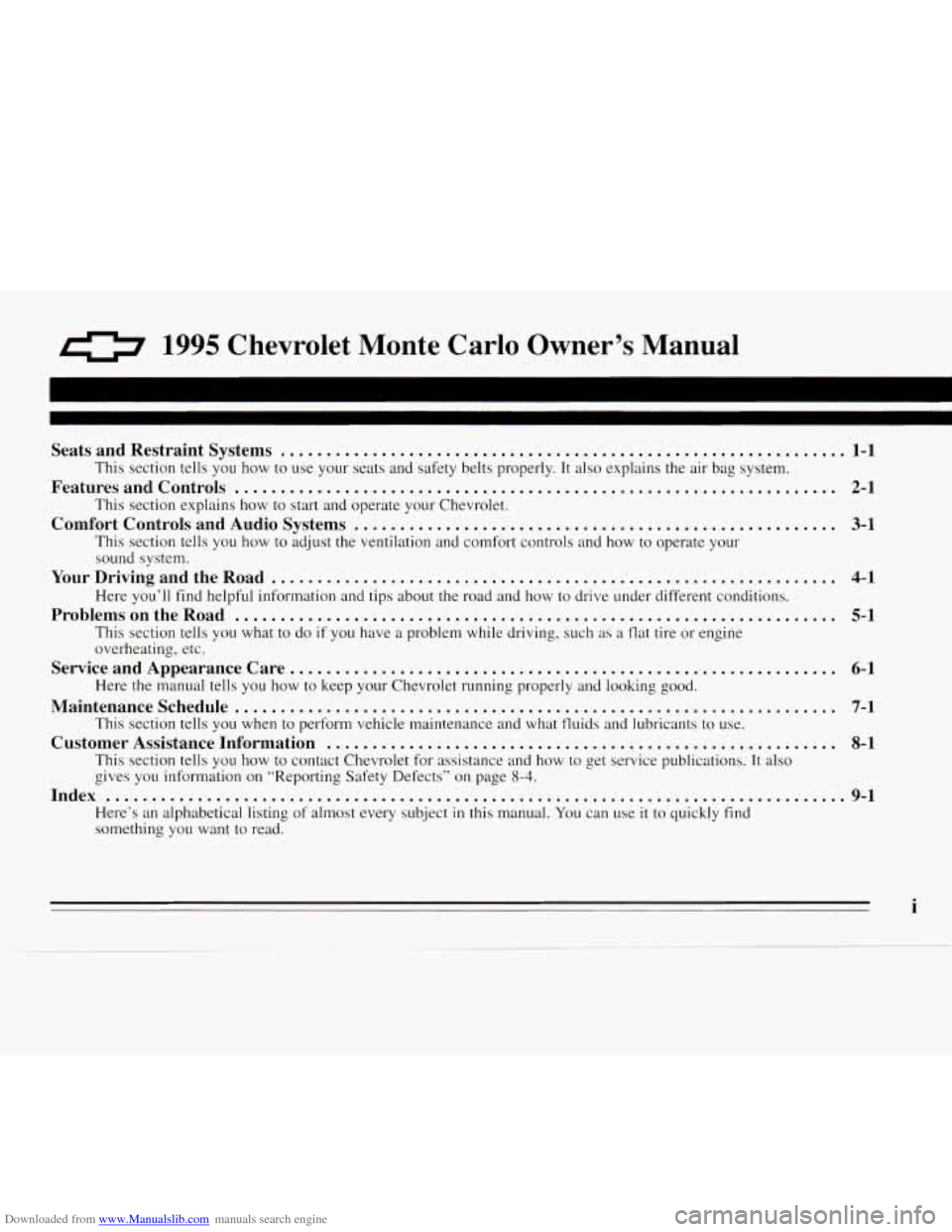
Downloaded from www.Manualslib.com manuals search engine 0 1995 Chevrolet Monte Carlo Owner's Manual
Seats and Restraint Systems .............................................................. 1-1
Featuresandcontrols .................................................................. 2-1
Comfort Controls and Audio Systems ..................................................... 3-1
This section tells you how to use your scats and safety belts properly. It also explains the air bag system.
This section explains how
to start and operate your Chevrolet.
This section tells you how
to adjust the ventilation and comfort controls and how to operate your
sound system.
Here
you'll find helpful inforlnation and tips about the road and how to drive under different conditions.
This section tells you what
to do if you have a problem while driving. such as a flat tire or engine
overheating, etc.
Here the
~nanual tells you how to keep your Chevrolet running properly and looking good.
This section tells you when
to perform vehicle maintenance and what tluids and lubricants to use.
This section tells you how to contact Chevrolet for assistance and how to get service publications. It also
gives you information on "Reporting Safety Defects" on page 8-4.
Here's an alphabetical listing of almost every subject in this manual. You can use it to quickly find
something you want to read.
Your Driving and the Road .............................................................. 4-1
Problems on the Road .................................................................. 5-1
Service and Appearance Care.. .......................................................... 6-1
Maintenanceschedule .................................................................. 7-1
Customer Assistance Information ........................................................ 8-1
Index ........................................................................\
......... 9-1
1
Page 10 of 324

Downloaded from www.Manualslib.com manuals search engine Vehicle Symbols
These are some of the symbols you may find on your vehicle.
For example, these symbols
are used on an
original battery:
POSSIBLE A
CAUTION
INJURY
PROTECT EYES BY
SHIELDING
CAUSTIC
ACID COULD
x
BATTERY
CAUSE
BURNS
AVOID
SPARKS
OR
FLAMES
SPARK
OR ,\I/,
COULD FLAME
EXPLODE BAllERY
These symbols are important
for you and
your passengers whenever your
vehicle
is
driven:
DOOR LOCK
UNLOCK
FASTEN SEAT
4
BELTS
POWER
WINDOW
These symbols have
to do with
your lights:
SIGNALS e
TURN
HIGH
LAMPSoR BEAM = =o
FOG LAMPS $0
These symbols are
on solne of
your controls:
WIPER Q
f0 -** -1
WINDSHIELDQ
WASHER I
WINDSHIELD
DEFROSTER
WINDOW
DEFOGGER
VENTILATING FAN
These symbols are used
on
warning and
indicator lights:
COOLANT F-
TEMP --
ENGINE
CHARGING
I-1
BATTERY SYSTEM
BRAKE
(@)
RADIATOR COOLANT
a
FUEL e3
ENGINE OIL
PRESSURE
Wb
TEMP OIL 9b
ANTI-LOCK (@)
BRAKE
Here are some other symbols
you may see:
FUSE J
RADIO k
VOLUME a
CONDITIONING AIR a
t
LIGHTER m
viii
Page 99 of 324

Downloaded from www.Manualslib.com manuals search engine Charging System Light
Fuel Gage
E F
Your fuel gage tells you
about how much fuel you
have left when the ignition
is on. When the indicator
nears EMPTY
(E), you still
have a little fuel left, but
you should get more soon.
Here are some things owners ask about. All these
situations are normal and do not show a problem with
your fuel gage:
At the service station, the pump shuts off before the
gage reads
FULL (F).
0 It takes a little more or less fuel to fill up than the gage
indicated. For example, the gage may have indicated
the tank was half full, but it actually took a little more
or less than half
the tank’s capacity to fill it.
The gage moves a little when you turn a corner or
speed
up.
c7
VOLTS
The
will
YOU
charging system light
come on briefly when
turn on the ignition, as
a check to show you it’s
working. Then it should go
out.
If it stays on, or comes on while you are driving, you
may have a problem with the charging system. It could
indicate that you have a loose drive belt or another
electrical problem. Have it checked right away. Driving
while this light is
on could drain your battery.
If you must drive a short distance with the light on, be
certain to turn
off all your accessories, such as the radio
and air conditioner.
2-43
Page 111 of 324
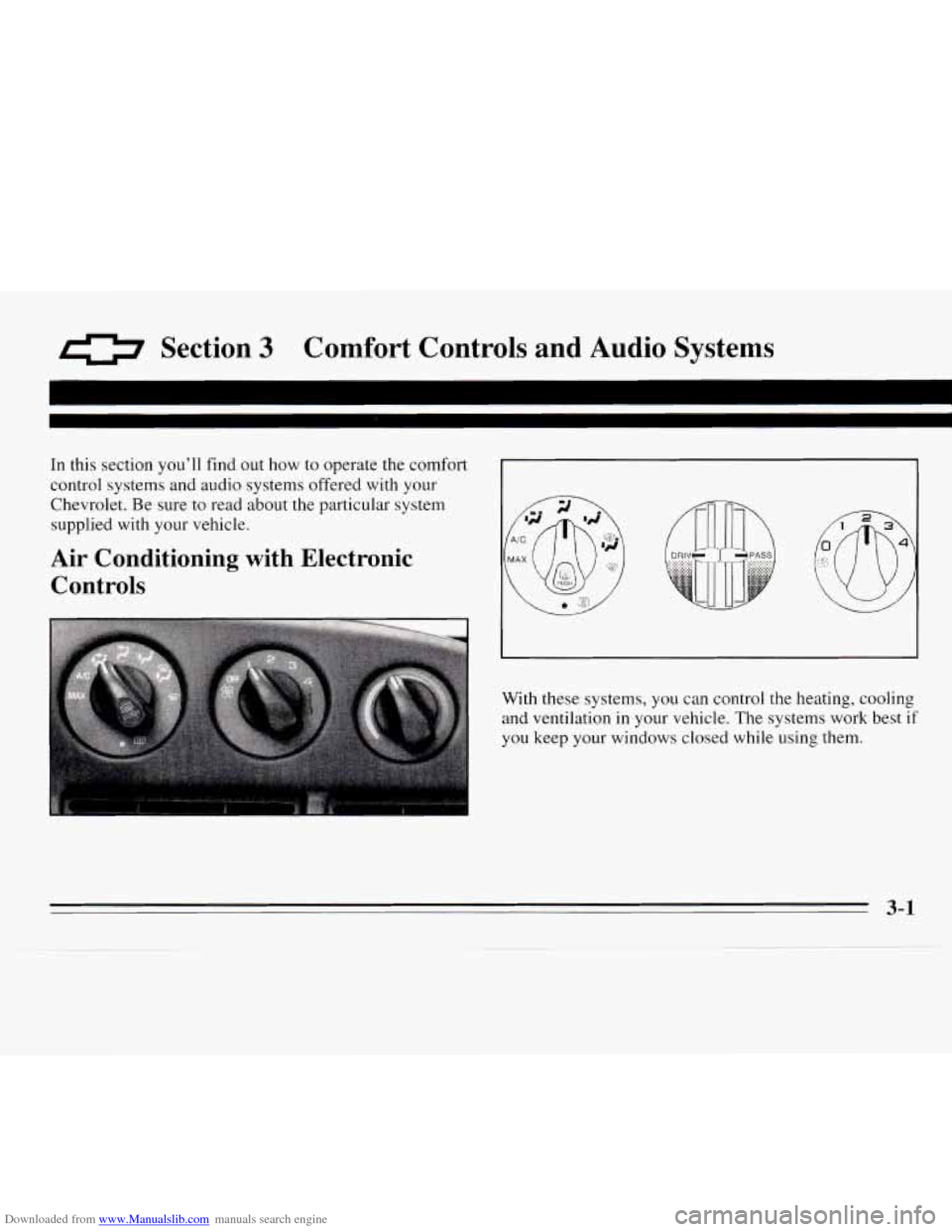
Downloaded from www.Manualslib.com manuals search engine 0 Section 3 Comfort Controls and Audio Systems
In this section you’ll find out how to operate the comfort
control systems and audio systems offered with your
Chevrolet. Be sure to read about
the particular system
supplied with your vehicle.
Air Conditioning with Electronic
Controls @ . !.
With these systems, you can control the heating, cooling
and ventilation in your vehicle. The systems work best if
you keep your windows closed while
using them.
3-1
Page 113 of 324
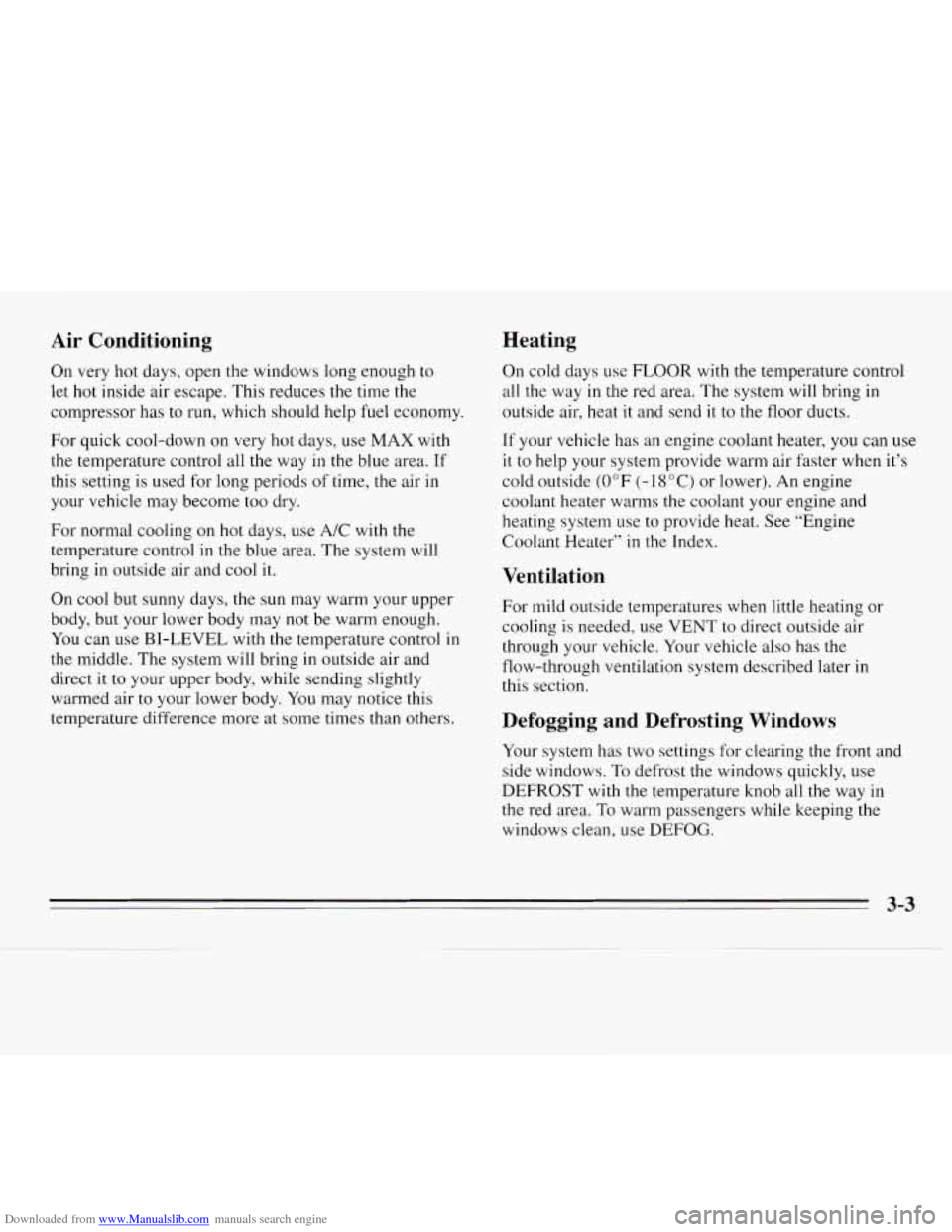
Downloaded from www.Manualslib.com manuals search engine Air Conditioning
On very hot days, open the windows long enough to
let
hot inside air escape. This reduces the time the
compressor has to run, which should help fuel economy.
For quick cool-down on very hot days, use
MAX with
the temperature control all the way in the blue area. If
this setting is used for long periods of time, the air in
your vehicle may become too dry.
Heating
For normal cooling on hot days, use A/C with the
temperature control in the blue area. The system will
bring in outside air and cool it.
On cool but sunny days, the sun may warm your upper
body, but your lower body may not be warm enough.
You can use BI-LEVEL with the temperature control in
the middle. The system will bring in outside air and
direct it to your upper body, while sending slightly
warmed air to your lower body. You may notice this
temperature difference more at some times
than others. On
cold days use FLOOR with the temperature control
all the way in the red area. The system will bring in
outside air, heat it and send it to the floor ducts.
If your vehicle has an engine coolant heater, you can use
it
to help your system provide warm air faster when it’s
cold outside
(0°F (-18°C) or lower). An engine
coolant heater warms the coolant your engine and
heating system use to provide heat. See “Engine
Coolant Heater”
in the Index.
Ventilation
For mild outside temperatures when little heating or
cooling
is needed, use VENT to direct outside air
through your vehicle. Your vehicle also has the
flow-through ventilation system described later
in
this section.
Defogging and Defrosting Windows
Your system has two settings for clearing the front and
side windows.
To defrost the windows quickly, use
DEFROST with the temperature knob all
the way in
the red area. To warm passengers while keeping the
windows clean, use
DEFOG.
3-3
Page 114 of 324
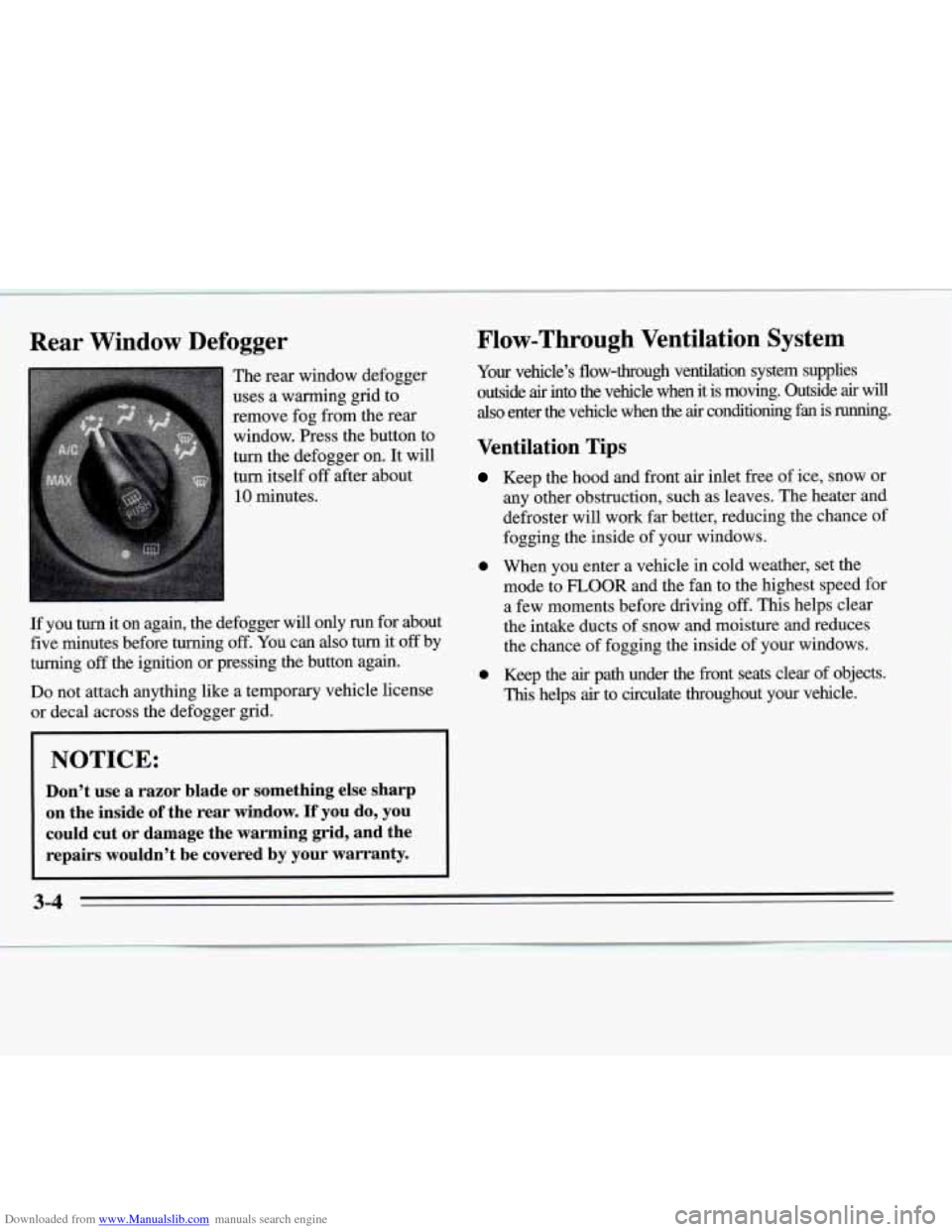
Downloaded from www.Manualslib.com manuals search engine Rear Window Defogger
The rear window defogger
uses a warming grid to
remove fog from the rear
window. Press the button to
turn the defogger on. It will
turn itself-off after about
10 minutes.
Flow-Through Ventilation System
Your velucle's flow-through ventilation system supplies
outside
air into the vehicle when it is moving. Outside air will
also enter the vehicle when the air conditioning fan is running.
Ventilation Tips
Keep the hood and front air inlet free of ice, snow or
any other obstruction, such as leaves. The heater and
defroster will work far better, reducing the chance of
fogging the inside of your windows.
If you
turn it on again, the defogger will only run for about
five minutes before turning
off. You can also turn it off by
turning
off the ignition or pressing the button again.
Do not attach anything like a temporary vehicle license
or decal across the defogger
grid.
NOTICE:
Don't use a razor blade or something else sharp
on the inside of the rear window. If you do,' you
could cut or damage the warming grid, and the
repairs wouldn't be covered by your warranty.
0 When you enter a vehicle in cold weather, set the
mode to
FLOOR and the fan to the highest speed for
a few moments before driving off. This helps clear
the intake ducts
of snow and moisture and reduces
the chance of fogging the inside of your windows.
0 Keep the air path under the front seats clear of objects.
This helps air to circulate throughout your vehicle.
3-4
Page 141 of 324
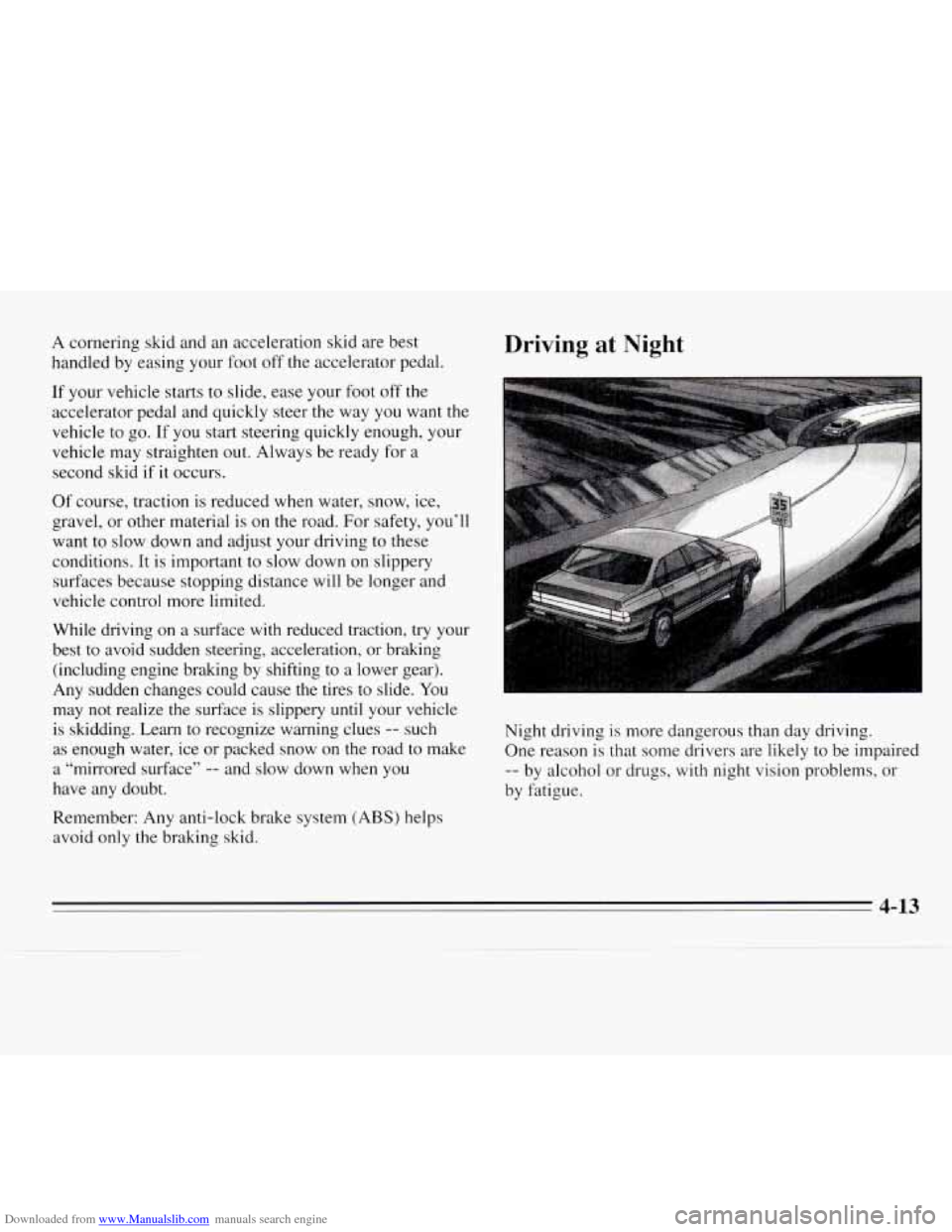
Downloaded from www.Manualslib.com manuals search engine A cornering skid and an acceleration skid are best
handled by easing your foot off the accelerator pedal.
If your vehicle starts to slide, ease your foot off
the
accelerator pedal and quickly steer the way you want the
vehicle to go. If you start steering quickly enough, your
vehicle may straighten out. Always be ready for a
second skid if it occurs.
Of course, traction is reduced when water, snow, ice,
gravel, or other material is on the road. For safety,
you’ll
want to slow down and adjust your driving to these
conditions. It is important to slow down on slippery
surfaces because stopping distance will be longer and
vehicle control more limited.
While driving on
a surface with reduced traction, try your
best to avoid sudden steering, acceleration, or braking
(including engine braking by shifting to a lower gear).
Any sudden changes could cause the tires to slide.
You
may not realize the surface is slippery until your vehicle
is skidding. Learn to recognize warning clues
-- such
as enough water, ice or packed snow on the road to make
a “mirrored surface”
-- and slow down when you
have any doubt.
Remember: Any anti-lock brake system
(ABS) helps
avoid only
the braking skid.
Driving at Night
F _+--
Night driving is more dangerous than day driving.
One reason is that some drivers are likely to be impaired
-- by alcohol or drugs, with night vision problems, or
by fatigue.
4-13
Page 175 of 324

Downloaded from www.Manualslib.com manuals search engine I NOTICE:
If your engine catches fire because you keep
driving with no coolant, your vehicle can be
badly damaged. The costly repairs would not
be covered by your warranty.
If No Steam Is Coming From Your Engine
If you get the overheat warning but see or hear no
steam, the problem may not be too serious. Sometimes
the engine can get a little too hot when you:
0 Climb a long hill on a hot day.
0 Stop after high speed driving.
Idle for long periods in traffic.
Tow a trailer. If you
get the overheat warning with no sign of steam,
try this for a minute or
so:
1. Turn off your air conditioner.
2. Turn on your heater to full hot at the highest fan
speed and open the window as necessary.
otherwise, shift to the highest gear while driving
--
OVERDRIVE (@) or DRIVE (D).
3. If you’re in a traffic jam, shift to NEUTRAL (N);
If you no longer have the overheat warning, you can
drive. Just
to be safe, drive slower for about ten minutes.
If the warning doesn’t come back on, you can drive
normally.
If the waning continues, pull over, stop, and
park your
vehicle right away.
If there’s still no sign
of steam, you can idle the engine
for two or three minutes while you’re parked,
to see
if the warning stops. But then, if you still have the
warning,
turn off the engine and get everyone out of
the vehicle until it cools down.
You may decide not to lift the hood but to get service
help right away.
5-13